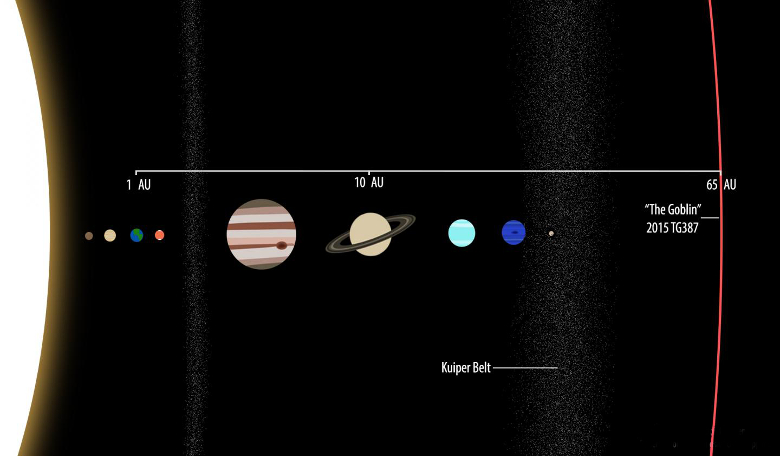A newly discovered object the size of a dwarf planet has been spotted on the fringes of the Solar System, and its presence adds further weight behind the theory that a much larger, mysterious Planet X is still out there waiting to be found.
Officially known as 2015 TG387, this 300 kilometre wide newly discovered object has been nicknamed the Goblin and was discovered about 80 astronomical units (AU) from the Sun; an astronomical unit is the mean distance from the centre of the earth to the centre of the sun - so around 149.6 million kilometres. For comparison, Pluto is around 34 AU away and like Pluto, the Goblin will not see much in the way of Sunlight as the closest it gets to the Sun is around 65 AU.
Despite a name that suggests a fiendish creature, its discovery is anything but. Detected by Scott Sheppard, Chad Trujillo and David Tholen, this trio are on the hunt for unknown dwarf planets as part of one of the largest and deepest surveys ever conducted for distant Solar System objects.
"These distant objects are like breadcrumbs leading us to Planet X. The more of them we can find, the better we can understand the outer Solar System and the possible planet that we think is shaping their orbits – a discovery that would redefine our knowledge of the Solar System's evolution," Sheppard explained.
Prior to finding the Goblin, Sheppard and Trujillo had already found 2012 VP113 – the most-distant object to date. It was around this discovery a few years ago that Sheppard and Trujillo noticed that the orbits of several other extremely distant Solar System objects all swung out in one direction – an unexpected feature that caused some consternation.
And while it seemed an outlandish idea at the time, the duo proposed the presence of an unknown planet on the periphery of the Solar System that was keeping these orbits in place. Planet X as it became known, is thought to be a sub-Neptune sized planet but with an orbit 20 times as large Neptune. Many exo-systems have planets in this mass range, but so far, our Solar System seems to lacking one.
If the data seems to point to Planet X’s existence, why haven’t we seen any tangible evidence of it yet? The orbital period of Earth (how long it takes for our planet to go once around the Sun) is one year. Jupiter’s orbital period is about 12 years, Saturn’s is 29 years and Uranus completes its orbital period once in a human lifetime. Planet X on the other hand, which is postulated to be 60 billion miles from the Sun, is expected to take 20,000 years to complete one orbit around the Sun!
Simulations of the orbit of 2015 TG387 by Trujillo and University of Oklahoma's Nathan Kaib have showed that if planet X is lurking out there, then it is keeping the Goblin at arms length so that it never gets too close to the massive planet. This behaviour is already seen with Pluto and Neptune, as Pluto never strays too close to the ice giant even though their orbits cross.
"What makes this result really interesting is that Planet X seems to affect 2015 TG387 the same way as all the other extremely distant Solar System objects. These simulations do not prove that there's another massive planet in our Solar System, but they are further evidence that something big could be out there" said Trujillo.
The team speculate that there could be thousands of small bodies like 2015 TG387 out on the fringes of the Solar System, but their distance make them difficult to find. "These so-called Inner Oort Cloud objects like 2015 TG387, 2012 VP113, and Sedna are isolated from most of the Solar System's known mass, which makes them immensely interesting," Sheppard said. "They can be used as probes to understand what is happening at the edge of our Solar System."











